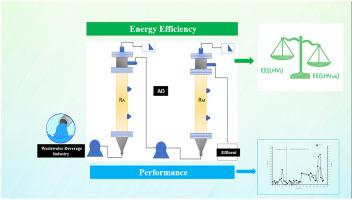Biomass & Bioenergy ( IF 5.8 ) Pub Date : 2021-10-01 , DOI: 10.1016/j.biombioe.2021.106260 Karol L. Fuentes 1 , Patricia Torres–Lozada 2 , Tatiana R. Chaparro 1

|
This study evaluated an anaerobic digestion (AD) process in two-stage for both organic matter removal and energy production, treating wastewaters from the beverage industry. The experimental studies were carried out in a continuous mode in an acidogenic reactor (RA) followed by a methanogenic reactor (RM) with a Hydraulic Retention Time (HRT) of 8h and 16 h, respectively, for 107 days. During this period, the geometric mean value of pH in the effluent of the system (RA+RM) was 7.3 and did not show a clear response to organic load rate (OLR) that were in a range of 14.66–50.15 kgCOD/m3·d, while the buffer capacity indicators, intermediate/partial alkalinity (IA/PA) ratio, and FOS/TAC were more effective in monitoring the process stability. IA/PA of 0.34 and a FOS/TAC of 0.18 assured a stable process and prevent an acidic shock for this type of wastewaters. Concerning the energy efficiency (EE) evaluated in the RA, the determining factor was the Low Heating Value (LHV), was directly proportional to the molar fraction of the gas. In particular, the adjusted LHV was 0.51 kJ/mol while the ideal LHV was 242 kJ/mol and the EE was 1.71% and 0.017% respectively. These results evidenced that is necessary to improve the mechanism to monitoring the AD process in each stage to maintain the stability, which will also allow increasing the energy efficiency in the whole system (RA+RM).
中文翻译:

两级厌氧消化饮料废水有机物脱除和能源生产
本研究评估了用于有机物去除和能源生产的两阶段厌氧消化 (A D)工艺,用于处理饮料行业的废水。实验研究在产酸反应器 (R A ) 和产甲烷反应器 (R M )中以连续模式进行,水力停留时间 (HRT) 分别为 8 小时和 16 小时,持续 107 天。在此期间,系统出水 (R A +R M )中 pH 的几何平均值为 7.3,并且对有机负荷率 (OLR) 的响应范围为 14.66–50.15 kgCOD/米3·d,而缓冲容量指标、中/偏碱度(IA/PA)比和FOS/TAC在监控过程稳定性方面更有效。0.34 的 IA/PA 和 0.18 的 FOS/TAC 确保稳定的过程并防止此类废水的酸性冲击。关于在 R A 中评估的能量效率 (EE) ,决定因素是低热值 (LHV),它与气体的摩尔分数成正比。特别是,调整后的 LHV 为 0.51 kJ/mol,而理想的 LHV 为 242 kJ/mol,EE 分别为 1.71% 和 0.017%。这些结果证明,有必要改进监控每个阶段 AD 过程的机制以保持稳定性,这也将允许提高整个系统的能源效率(R A+R M )。









































 京公网安备 11010802027423号
京公网安备 11010802027423号